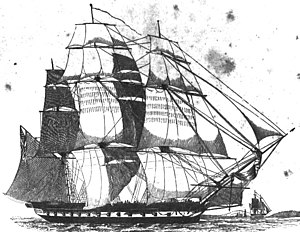USS United States (1797)
 |
|
| History | |
|---|---|
|
|
|
| Name: | USS United States |
| Namesake: | United States of America |
| Ordered: | 27 March 1794 |
| Builder: | Joshua Humphreys |
| Cost: | $299,336 |
| Launched: | 10 May 1797 |
| Nickname(s): | "Old Wagon"; "Old Waggon" |
| Fate: | Abandoned 20 April 1861 |
|
|
|
| Name: | CSS United States |
| Acquired: | 20 April 1861 |
| Fate: | Abandoned May 1862 |
|
|
|
| Name: | USS United States |
| Acquired: | May 1862 |
| Fate: | Broken up December 1865 |
| General characteristics | |
| Class and type: | First class frigate |
| Tons burthen: | 1576 tons |
| Length: | 175 ft (53 m) between perpendiculars |
| Beam: | 43 ft 6 in (13.26 m) |
| Draft: | 23 ft 6 in (7.16 m) aft |
| Decks: | Orlop, Berth, Gun, Spar |
| Propulsion: | Sail |
| Speed: | 11 kn (20 km/h; 13 mph) |
| Complement: | 400 to 600 officers, enlisted personnel and 50 Marines |
| Armament: | 32 × long 24 pounders (11 kg), 24 × 42 pounder (19 kg) carronades (War of 1812) |
USS United States was a wooden-hulled, three-masted heavy frigate of the United States Navy and the first of the six original frigates authorized for construction by the Naval Act of 1794. Joshua Humphreys designed the frigates to be the young Navy's capital ships, and so United States and her sisters were larger and more heavily armed and built than standard frigates of the period. She was built at Humphrey's shipyard in Philadelphia, Pennsylvania and launched on 10 May 1797 and immediately began duties with the newly formed United States Navy protecting American merchant shipping during the Quasi-War with France.
In 1861 United States was in port at Norfolk and was seized by the Virginia Navy and subsequently commissioned into the Confederate navy as CSS United States, but was later scuttled by Confederate forces. Union forces raised the scuttled ship, and retained control of the ship until she was broken up in 1865.
During the 1790s American merchant vessels began to fall prey to Barbary pirates in the Mediterranean, most notably from Algiers. Congress's response was the Naval Act of 1794. The Act provided funds for the construction of six frigates; however, it included a clause stating that construction of the ships would cease if the United States agreed to peace terms with Algiers.
Joshua Humphreys' design was long on keel and narrow of beam (width) for mounting very heavy guns. The design incorporated a diagonal scantling (rib) scheme to limit hogging while giving the ships extremely heavy planking. This gave the hull greater strength than those of more lightly built frigates. Humphreys developed his design after realizing that the fledgling United States could not match the navy sizes of the European states. He therefore designed his frigates to be able to overpower other frigates, but with the speed to escape from a ship of the line.
...
Wikipedia
